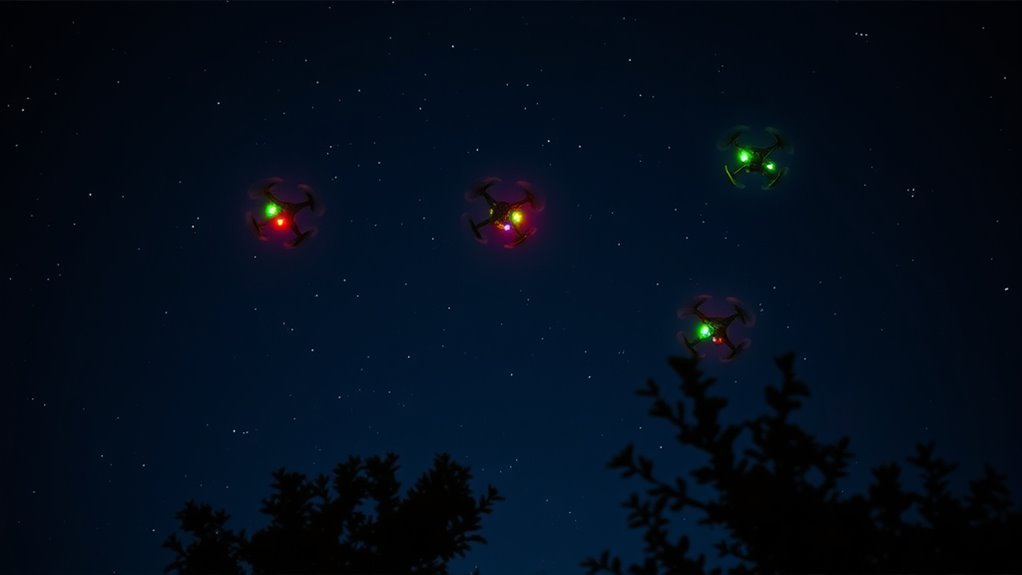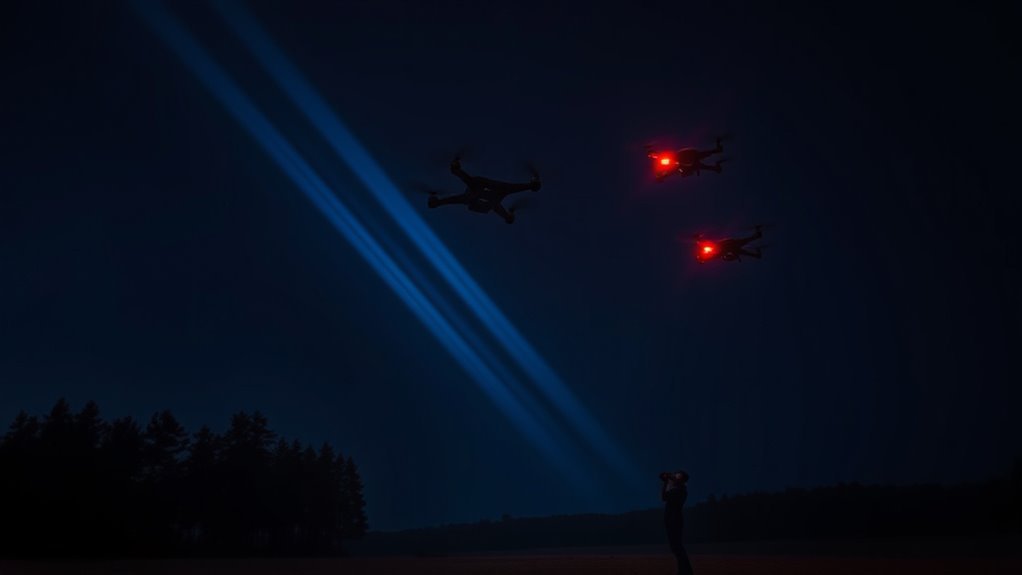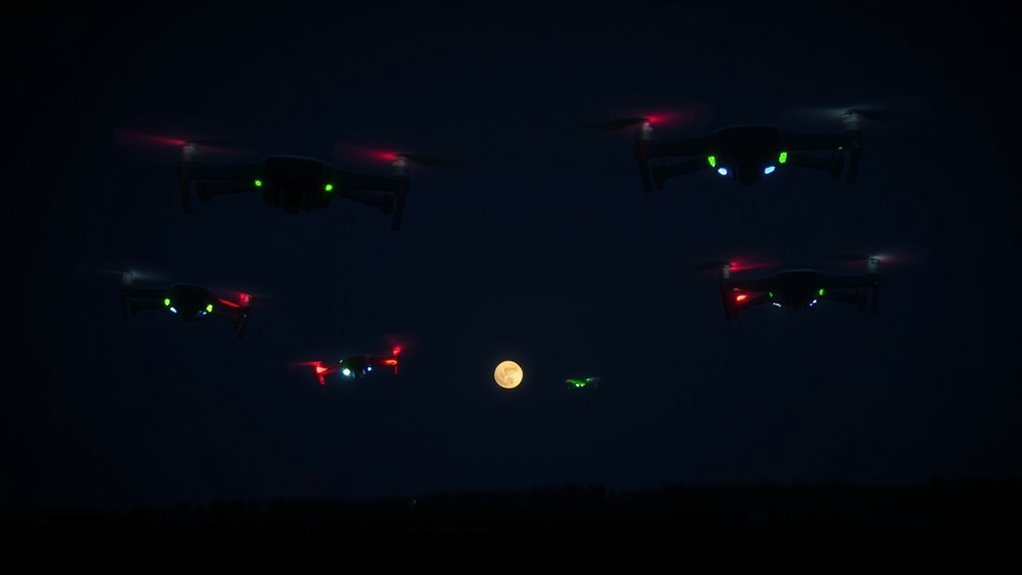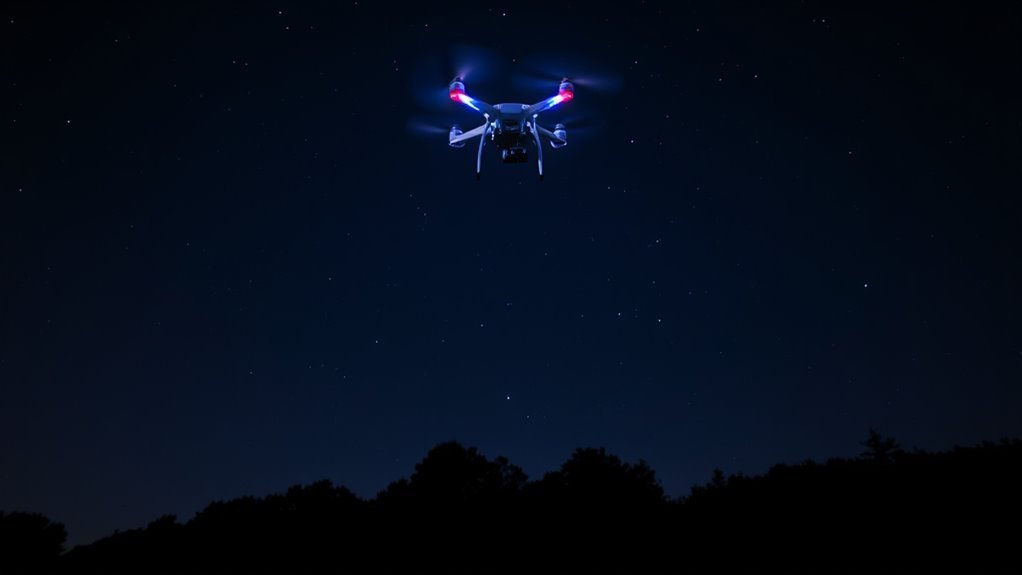When spotting drones at night, look for navigation lights: red on the left, green on the right, and white in front. Listen for the distinctive buzzing sound, which varies with drone size. Observe flight patterns; erratic movements suggest recreational use, while smooth paths indicate commercial purposes. Understand the legal regulations in your area to guarantee safe observation. Knowing these basics will help you identify drones effectively. There’s much more to explore about drone spotting techniques.
Understanding Drone Navigation Lights

While you might not think much about navigation lights during the day, they become essential for spotting drones at night. Understanding drone light colors and navigation light patterns allows you to identify different types of drones and their movements. Typically, drones use red and green lights to indicate their orientation; a red light usually means the left side, while green indicates the right. White lights often signify the drone’s front. Familiarizing yourself with these colors and patterns helps you quickly assess a drone’s direction and altitude. When you’re out at night, knowing how to interpret these lights not only enhances your awareness but also supports your freedom to navigate the skies responsibly. Additionally, being aware of regulatory oversight can help you understand the parameters within which drones operate, further enhancing your situational awareness. Stay vigilant, and you’ll spot drones with ease. Moreover, understanding the noise levels produced by drones can also help you identify their presence, as louder drones are typically more noticeable at night.
Recognizing Drone Sounds

When trying to spot drones at night, recognizing their sounds is essential. You’ll notice distinctive propeller noises, electronic beeping signals, and variations in engine throttle that can help identify their presence. By honing in on these audio cues, you can enhance your ability to detect drones in the dark.
Distinctive Propeller Noise
The unmistakable sound of a drone’s propellers slices through the night air, making it a key indicator of its presence. Understanding this propeller noise can enhance your ability to identify drones. Here are some factors to take into account:
- Pitch: Higher frequencies can indicate smaller drones.
- Rhythm: A consistent beat suggests a stable flight pattern.
- Volume: Louder sounds may hint at proximity.
- Variations: Changes in sound frequency can signal maneuvers or altitude adjustments.
Electronic Beeping Signals
Distinctive propeller noise isn’t the only auditory cue to help you spot drones at night. Pay attention to electronic beeping signals, which can vary in intensity and frequency. These beeping patterns often indicate operational modes, such as hovering or returning to base. By recognizing the specific signal frequency, you can determine if a drone is nearby, even in low visibility. Most drones emit distinct sounds that are unlike common nighttime noises, making them easier to identify. If you hear intermittent beeping, it’s essential to gauge the proximity and direction of the source. This auditory awareness can enhance your ability to maintain your freedom in the airspace you cherish, allowing for a more informed response to any encroaching technology.
Engine Throttle Variations
Although you might not immediately associate engine throttle variations with drone identification, these subtle shifts in sound can provide essential insights into a drone’s operation. Paying attention to these variations can help you gauge the drone’s engine performance and throttle response, allowing you to determine its activity.
- Constant hum: Indicates stable flight, possibly hovering.
- Rapid changes: Suggests maneuvers or adjustments in altitude.
- Pulsing sound: May signal an engine struggling or optimizing performance.
- Distant roar: Can imply a larger drone or one with enhanced capabilities.
Observing Flight Patterns

While you’re scanning the night sky for drones, observing their flight patterns can provide crucial insights into their operation and purpose. Pay attention to their flight behavior; erratic movements may indicate recreational use, while smooth, deliberate paths often suggest commercial or surveillance activities. Note any altitude changes—drones typically fly at varying heights for specific tasks. For instance, a drone descending rapidly might be landing or adjusting its operation, whereas a steady ascent could suggest it’s surveying an area. By tracking these patterns over time, you can develop a deeper understanding of the drone’s intent and its role in the airspace. This knowledge can empower you to advocate for your freedom and privacy in an increasingly monitored world. Additionally, understanding a drone’s flight time capabilities can further inform your observations and assessments of its operational purpose. Drones with battery life optimized for distance can cover larger areas before returning home, impacting their flight patterns significantly.
Identifying Drone Sizes and Shapes
Understanding the flight patterns of drones can lead you to notice their sizes and shapes, which play a significant role in their functionality and intended use. By observing drone silhouettes against the night sky, you can make informed judgments about their purpose.
- Quadcopters: Commonly small and lightweight, ideal for hobbyists.
- Fixed-Wing Drones: Larger and more aerodynamic, suited for longer flights.
- Racing Drones: Compact with a unique shape, designed for speed.
- Commercial Drones: Vary in size, often larger for stability and payload capacity.
Additionally, the technology used in drones, such as swarm technology, enhances their capability to perform complex maneuvers, which can be observed in aerial displays.
Using Night Vision Equipment
When it comes to spotting drones at night, using the right type of night vision equipment can make all the difference. You’ll find various night vision technologies available, each with unique strengths suited to different viewing conditions. Understanding these options and their ideal usage will enhance your ability to detect drones effectively in low-light environments.
Types of Night Vision
There are several types of night vision equipment available, each designed to enhance visibility in low-light conditions. Understanding these options can help you choose the right tool for spotting drones effectively.
- Gen 1 Night Vision: Affordable, uses light amplification but less effective in total darkness.
- Gen 2 Night Vision: Improved clarity and brightness, suitable for most nighttime activities.
- Gen 3 Night Vision: Higher resolution and performance, often used by military and professionals.
- Thermal Imaging: Utilizes infrared technology to detect heat signatures, ideal for spotting drones regardless of light levels.
Each type has its unique strengths, making it essential to evaluate your needs to maximize your effectiveness in the field.
Optimal Viewing Conditions
Ideal viewing conditions are essential for making the most of your night vision equipment while spotting drones. To optimize your experience, you’ll want to evaluate weather conditions and ambient lighting. Here’s a quick reference table to help you gauge these factors:
| Weather Conditions | Ambient Lighting | Effectiveness |
|---|---|---|
| Clear | Low | High |
| Overcast | Moderate | Moderate |
| Rainy | Low | Low |
| Foggy | Low | Very Low |
In clear skies with low ambient light, your night vision gear will perform best, enhancing your ability to detect drones. If conditions aren’t ideal, you may miss critical details. Always check the forecast before heading out!
Distinguishing Drones From Other Aircraft
How can you tell a drone apart from traditional aircraft at night? Distinguishing drones involves specific drone identification techniques and aircraft comparison methods. Here are some key indicators to help you identify a drone:
- Size: Drones are usually smaller than traditional aircraft, often appearing as tiny lights.
- Sound: Many drones emit a distinct buzzing noise, unlike the smooth hum of larger aircraft.
- Flight Patterns: Drones often maneuver rapidly and can hover in place, unlike conventional planes.
- Lighting: Drones frequently have colored LED lights that can blink in various patterns, while traditional aircraft have steady navigation lights. Additionally, it’s important to note that flying a drone at lower altitudes can increase the risk of collision, emphasizing the need for adhering to altitude guidelines.
Legal Considerations for Spotting Drones at Night
As you spot drones at night, it’s important to be aware of the legal considerations surrounding their identification and use. Familiarize yourself with federal regulations and local laws, as these can vary greatly by location. Here’s a quick overview:
| Regulation Type | Federal Regulations | Local Laws |
|---|---|---|
| Drone Usage | FAA guidelines for night operations | Specific city or county ordinances |
| Privacy Rights | Protection against unauthorized surveillance | Varies; check local statutes |
| Airspace Restrictions | Class restrictions by the FAA | Local airspace rules |
| Registration | Mandatory for certain drone types | Additional local registration may apply |
| Penalties | Fines and legal action | Local enforcement actions |
Understanding these rules will help you navigate the complexities of drone spotting responsibly. Additionally, be aware of privacy concerns to ensure that your activities do not infringe on the rights of others. It is also essential to consider the importance of drone insurance to protect yourself against potential liabilities while operating your drone at night.
Frequently Asked Questions
Can I Use My Smartphone to Spot Drones at Night?
You can use smartphone apps with night vision capabilities to spot drones at night. These tools enhance your visibility, helping you track movements. Whether for safety or curiosity, your smartphone can be a powerful ally.
Are There Specific Times When Drones Are More Active at Night?
Drones tend to show increased activity during late evening hours, often aligning with night regulations. If you’re observing the skies, be aware that commercial and recreational users may operate more frequently after sunset.
What Colors Are Drone Navigation Lights Typically?
Drone navigation light colors typically include red, green, and white. These colors indicate orientation and direction, with specific navigation light patterns helping you identify a drone’s movements and position, enhancing your awareness and freedom to explore the skies.
How Can Weather Conditions Affect Drone Visibility at Night?
Ah, the drama of drone visibility! In foggy conditions or rainy nights, you’ll find those little flying machines vanish like your favorite snack. Weather seriously hampers their lights, making spotting them a true challenge.
Do Drones Make Noise When Flying at High Altitudes?
Drones do produce sound, but altitude effects can dampen this noise. As they fly higher, the sound diminishes due to distance and atmospheric conditions, making them harder to hear compared to lower flights.

